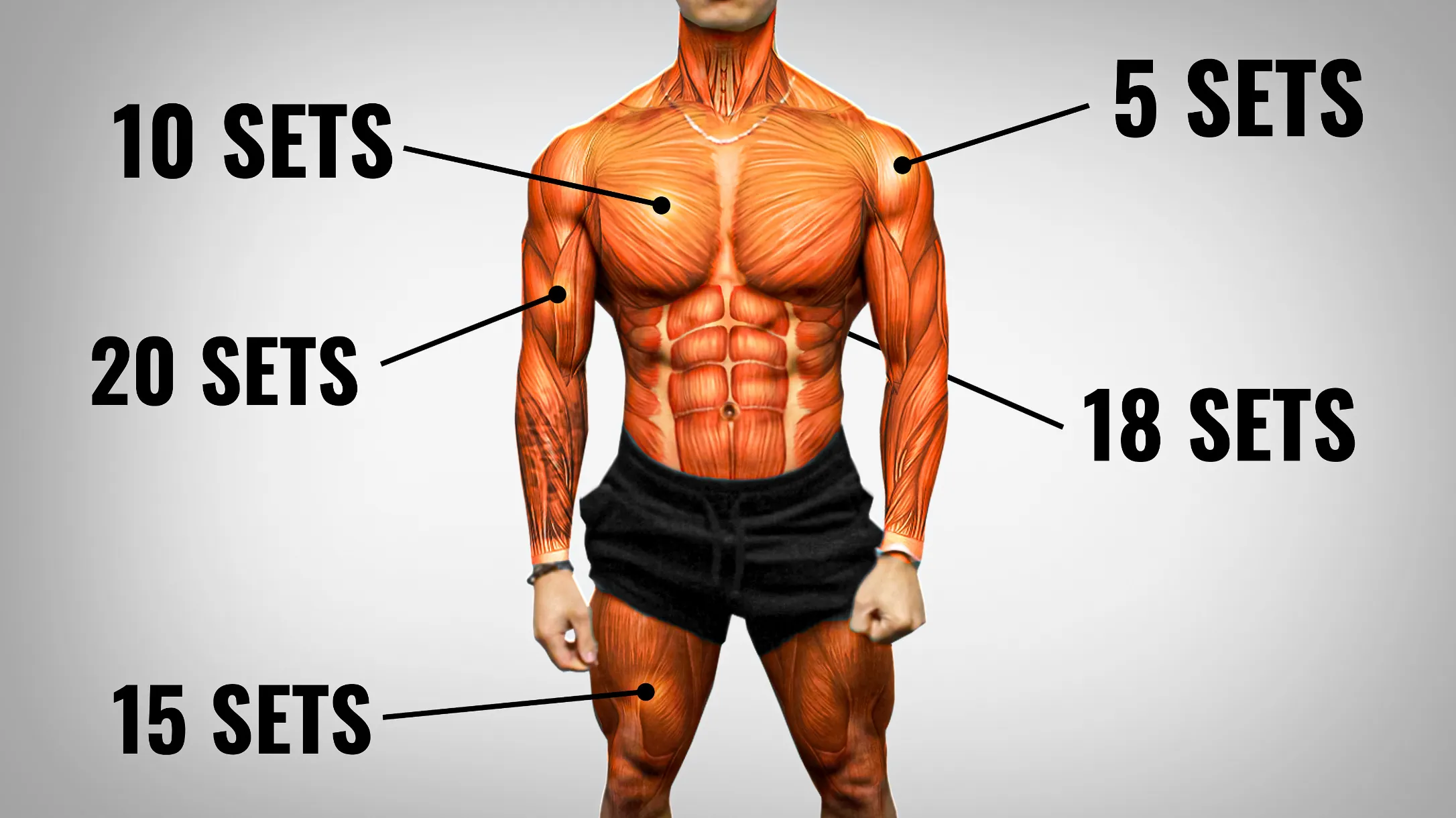
How Many Sets Per Muscle Group Per Week To Force Growth? (Less = More!)
How many sets per muscle group per week do you really need to build muscle?
Some say just 1 set taken to all-out failure is best. Dorian Yates and Mike Mentzer are prime examples of incredible physiques that have been built using this minimalistic approach.
Whereas others go high volume, doing 4-5 sets per exercise and taking over 3 hours to complete a workout.
Who’s right?
And more importantly, how many sets per muscle group per week should YOU do, especially as a natural?
Well, the answer might surprise you and is probably a lot less than you’re currently doing.
What Does Research Say?
The first major analysis investigating the relationship between how many sets per muscle group per week and resulting muscle growth was done in 2017, led by researcher Brad Schoenfeld.
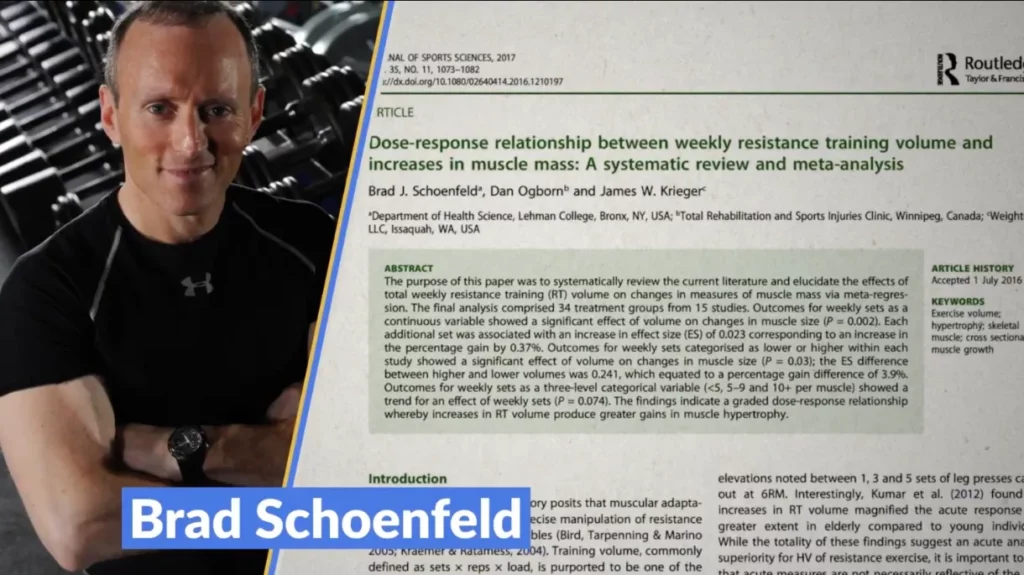
They compared:
- 1-5 sets
- 5-9 sets
- 10+ sets
... per muscle per week.
So, for example, 6 weekly sets for the chest could be 3 sets of bench and 3 sets of flyes.
Now what they discovered is a dose-response between muscle growth and the number of sets performed — with 10+ sets per muscle per week resulting in the most growth.
After this meta-analysis was published, pretty much all of us fitness nerds were under the impression that more volume was better.
I almost instantly bumped up the number of sets on all my exercises.
Unfortunately, it didn’t end up skyrocketing my gains the way I had hoped.
I only realized the mistake I made when more research came out.
You see, while this analysis did suggest that more was better, it didn’t let us know just how far we could push it while still continuing to see better gains.
Turns Out, More Is Not Always Better
Fortunately, 6 years later, a new group of researchers decided to perform a similar analysis on the relationship between how many sets per muscle group per week and hypertrophy outcomes.
But this time, they compared:
- Lower volumes of < 12 sets
- Moderate volumes of 12-20 sets
- High volumes of > 20 sets
... per muscle per week.
They also standardized the data by only looking at sets performed within 6-20 reps.
Although moderate and high volumes led to more growth compared to low volumes, in almost all the muscles measured, there were no significant differences between the two.
The one exception was the triceps, which responded better to higher volumes, but we’ll talk more about what this means later on.
But overall, this analysis suggests there may be some kind of “upper limit” to how many sets per muscle group per week you should do, where too much volume doesn’t lead to more growth and, in some cases, might even hinder growth.
The sweet spot for how many sets per muscle group per week to do seems to be somewhere within the range of 10-20 sets per muscle per week.
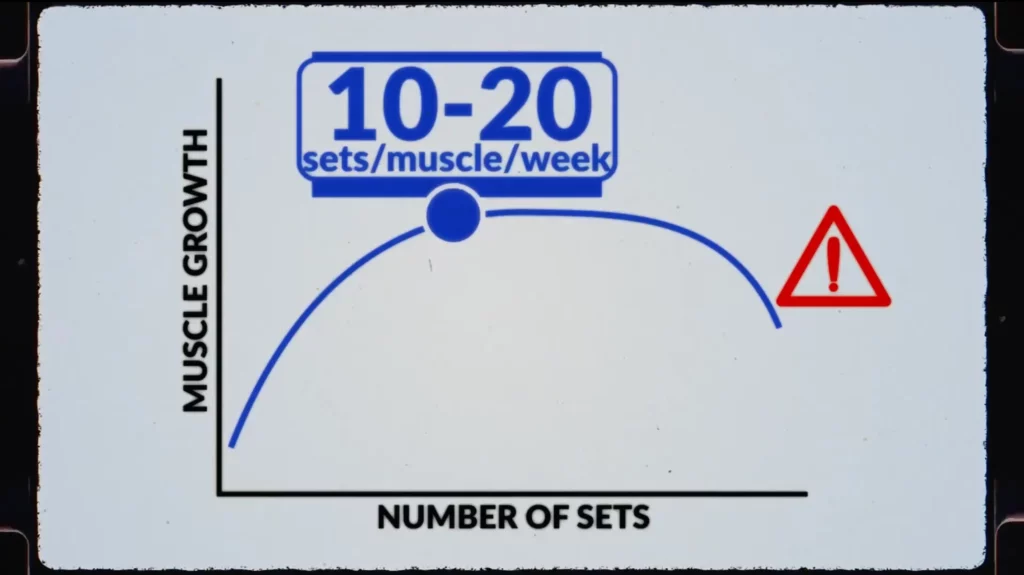
But this is still a very wide range. 20 sets is double the time and work compared to 10 sets.
How Many Sets Per Muscle Group Per Week You Should Do Depends on 5 Factors
To find where within this range is best for you (i.e. exactly how many sets per muscle group per week you should do), there are 5 other factors you need to consider.
#1: Individuality
The first of which is your individual response.
While the studies we covered earlier provide us with great insight into how many sets per muscle group per week are optimal, they look at averages to see what the best general recommendation is.
But in the case of volume, it seems to be highly individual.
I.e., how many sets per muscle group per week recommendations can differ from person to person.
Illustrating this is a 2016 study from the Journal of Sports Science, where they had 19 participants train one leg with 6-9 sets per week and their other leg with 15 sets per week.
After 8 weeks, roughly a third of the participants had a leg that responded better from low volume, a third had a leg that responded better from high volume, and a third had a similar response in both legs.
Suggesting that what one person can recover well and grow from may end up being too much for someone else.
#2: Exercise Execution
Now later in this article, I’ll show you guys how to determine if how many sets per muscle group per week you're currently doing is too much or too little for you.
But one thing that will play a big role in that is exercise execution.
You see, in most studies, a “set” is defined as going to or very close to complete failure.
But we know from past research that most people don’t push themselves hard enough to reach this point.
Or, as soon as they get anywhere close to it, they start cheating and using momentum.
So you may not need nearly as much volume as you think you do if you simply fixed these more important areas instead.
Let's hear from Max Euceda, a 22-year-old natural bodybuilder who experienced this firsthand:
It was probably maybe 30, 30 to 40 sets per muscle group per week. I mean, it was crazy.
With Chest Day, I was doing every chest movement I could think of, you know, upper chest flies, incline bench press, flat bench press.
I was doing incredibly high volume, and it, it got to the point where it was like, all these sets were sloppy. And, you know, I wasn't actually taking the muscles to failure.
I'd tell myself, all right, 30 reps of bicep curls, and I'll stop once I hit 30.
And in my last 15 I was, I was just swinging up and down. It was a mess.
And I mean, eventually, I got to a point where months down the line, I just wasn't seeing any progress in terms of, you know, my lifts weren't going up, I wasn't putting on any muscle.
So now I'm doing anywhere from seven to 12 sets per week per muscle group as opposed to, you know, 30 plus.
Definitely seen the most growth I've ever seen in terms of, you know, raining a quote-unquote a lower volume than normal. The thing that really helped me is, you know, training very close to failure.

Because when you're training very close to failure, your muscles just won't need that many sets.
But the thing is, you need to maintain good form.
When that set gets hard, you need to maintain good form.
If your form is breaking down to where, you know, you're using momentum, and your reps are getting super sloppy, then you know, you're not taking your muscles to failure.
The last thing I did when it came to lowering my volume that really helped was taking longer rest periods.
Because obviously, you know, when you're training very hard and very intensely, your muscles just need to require more rest.
So I think when you maintain proper technique, and you take your muscles to failure, then pair that with a lower volume approach, you're checking off everything on the list, right?
You're doing everything that you need to do without going overboard.
it's almost like a second phase of newbie gains because you actually start to train how you're supposed to train your muscles, and they will respond very well to that.
#3: Rest Times
You may have noticed Max mentioned that in addition to lowering his volume, he also ended up taking longer rest periods.
This is important to note because how long you rest will affect how much volume — i.e., how many sets per muscle group per week — you need to grow.
If you take shorter rests between sets, such as less than 2 minutes, research suggests you’ll need to do more sets to get the same amount of growth as you would from taking longer rest.
Unfortunately, the research I covered earlier that helped us come up with that 10-20 set recommendation used studies where the rest periods differed.
Some studies used short rests, whereas others used longer rests.
So if you usually take longer rest periods between most of your sets, I generally recommend at least 2 minutes between sets, it’s likely that the lower end of the range would be best (10-15 weekly sets).
Whereas the higher end of the range (15-20 weekly sets) likely be necessary if you mostly use shorter rest periods (less than 2 minutes between sets).
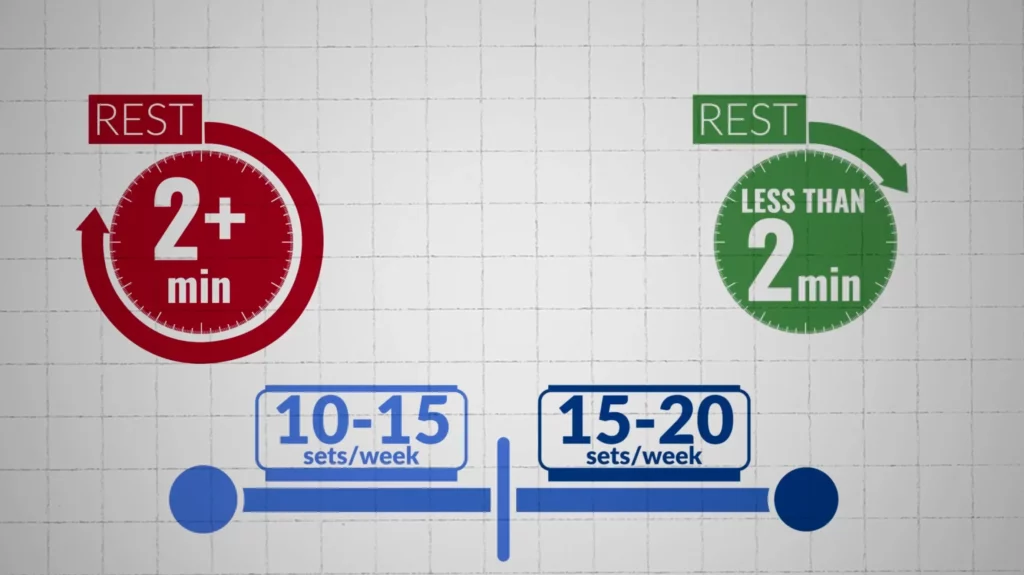
#4: How You Count Sets
But how many sets per muscle group per week you need also depends on the next factor, how you count your sets.
So you remember how in the meta-analysis we covered earlier, none of the muscles responded better to really high volumes except for the triceps?
Well, it’s important to consider how they counted their sets.
Generally, researchers still count muscles that are indirectly worked with an exercise as 1 full set for that muscle.
For example, during the bench press, they’ll count that as 1 set for the chest and 1 set for the triceps.
Now whether or not this should truly count as 1 set for the secondary muscles is up for debate, but it does affect the volume recommendations or, put simply, how many sets per muscle group per week you should do.
For example, even though the study showed the triceps responded really well to 20+ sets per week, if you look at the average person’s workout routine, this would only be about 6 direct sets for triceps if you also counted all the pressing movements they’re already doing.
The front, side, and rear delts, as well as the biceps, probably fall under this category as well.
Unless you want to prioritize them, they don’t need quite as many direct sets because of how often they’re indirectly worked.
This also applies to regions within a muscle.
The chest, for example, doesn’t need 10 sets each for the upper, middle, and lower portions.
Rather, the chest, in general, would require 10 weekly sets, and you’d ideally split those sets up by using exercises that emphasize the different regions.
Doing Just 1 To 2 Sets Can Work
I also think this discrepancy in how people count sets is why high-intensity training, where you do just 1 set (max 2 sets per exercise) CAN work, and HAS seemed to work for many people.
You see, in the research we covered, subjects would stop each set once they reached failure or were close enough to it.
Whereas Dorian Yates, 6-time Mr. Olympia who has popularized high-intensity training, does “one, all-out set extended beyond failure with forced reps, rest-pause reps, or drop set reps. A set is properly finished only when additional movement is utterly impossible.”
So as you can imagine, 1 set performed in this fashion could very likely be the same time under tension and stimulus that 2-3 normal sets would provide.
#5: Chasing "Optimal"
Lastly, and probably most importantly, not everyone should be doing what’s “optimal” when it comes to how many sets per muscle group per week you should be doing.
Although somewhere within 10-20 weekly sets is probably what will maximize growth, you’d be surprised with just how little volume you need to still get really good results.
10 sets won't give you double the growth as 5 sets.
Each additional set only gets you marginally better gains.
So if we look back at the 2017 meta-analysis I mentioned earlier, even though 10 or more weekly sets led to the most growth, 5-9 weekly sets still gave about 80% of the max growth.
For the chest, this could be as little as 3 sets of bench presses and 3 sets of flyes every week, which could pretty much cut your workout times in half.
In fact, in some cases, even in trained individuals, just 3 sets per muscle week has been shown to build some muscle.
So if you’re having trouble just being consistent in the first place, don’t chase the optimal guidelines when it comes to how many sets per muscle group per week you should be doing.
Do what you can and realize you can still get great results with far less than you think.
At the end of the article, I will be providing a free “minimalist” and “optimal” workout routine you can use with all the science and sets taken care of for you.
But first, let’s discuss how exactly to start applying all the research we’ve covered relating to how many sets per muscle group per week and its effect on muscle growth.
What To Do With All This Information
So ... how many sets per muscle group per week should you do?
First off, I’d recommend starting off at the low end of the 10-20 weekly set range, especially if you’re a beginner.
You don’t want to end up doing higher volumes than your body can handle.
For example, this is what 10 weekly sets could look like for the chest if you trained all your muscles twice a week, which is generally how I’d recommend splitting your volume up.
Day 1:
Bench press: 3 sets of 8-12 reps
Chest Flyes: 2 sets of 10-15 reps
Total: 5 sets
Day 2:
Incline dumbbell press: 3 sets of 8-12 reps
Chest Flyes: 2 sets of 10-15 reps
Total: 5 sets
Now even if you’re past the beginner stage, dial in your form, make sure you’re pushing hard enough, take longer rest periods, and it’s very likely you’ll start seeing better results despite doing far less than you were before.
But eventually, as you get more experienced you may reach a point where your body is actually ready for more volume.
Usually, this is when you’ve plateaued for quite some time and are struggling to further increase your strength and muscle size. But before making any changes, I’d recommend following a flow chart from “The Muscle & Strength Pyramids” book written by researcher Eric Helms.
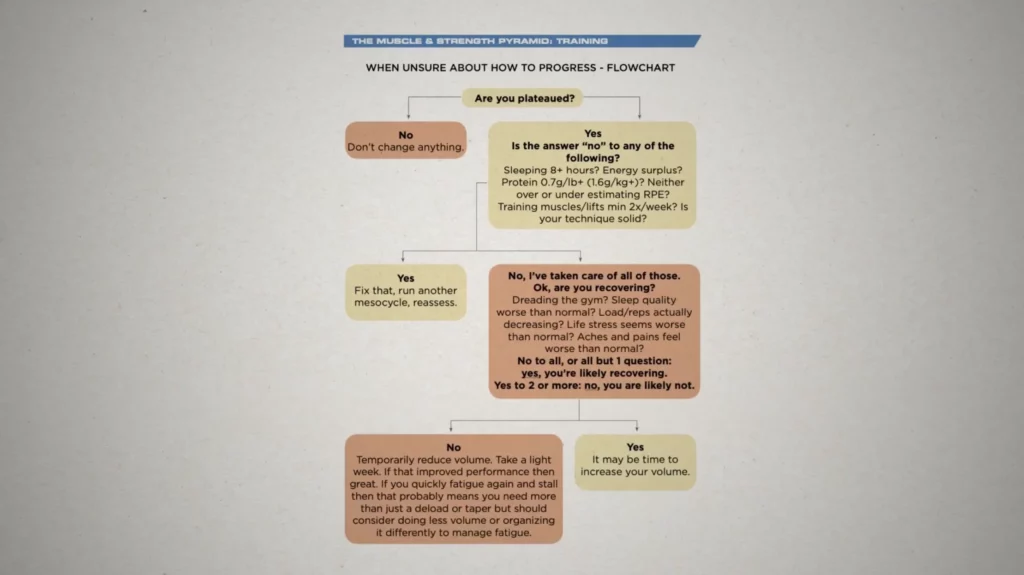
Here, you ask yourself a set of questions to determine whether you should increase volume (i.e., increase how many sets per muscle group per week you're doing) or maybe even decrease it.
For example, if you’re sleeping well, pushing hard with good form, and eating enough, yet you’re still not seeing gains, then chances are you might actually need more volume.
In this case, add about 2 more weekly sets, especially on muscles that are lagging behind, and see how you progress.
Otherwise, you might actually need to take a break or consider decreasing your volume.
But remember, how many sets per muscle group per week is optimal for your growth is very individual.
Experiment, listen to your body, and realize that you can still make incredible gains by just showing up and doing what you can, even if it’s less than what’s “optimal”.
TL;DR
- 10-20 sets seem to be the sweet spot for how many sets per muscle group per week to do.
- That said, how many sets you should do depends on 5 factors: 1) individuality, 2) exercise execution, 3) rest times duration, 4) how you count sets, and 5) whether you’re over-prioritizing “optimal” over consistency.
- Start off at the low end of the 10-20 weekly set range. Dial in your form, make sure you’re pushing hard enough, and take longer rest periods.
- Seeing a plateau in your gains doesn’t always mean you should increase volume.
- Only add 2 sets if you’re not seeing gains despite sleeping well, pushing hard with good form, and eating enough.
Grab Your Free Workout Plans
Now since you’ve stuck around for this long, I thought I’d leave you with a gift.



I’ve created 3 different weekly workout plans. A quick 3-day per week minimalist routine with around 6 sets per muscle, a 4-day per week routine with 10 sets per muscle to maximize gains, and a 5-day per week routine with around 14 sets per muscle for those who might need a little higher volume.
They're completely free, and you can grab these routines here:
Click the button below to grab your free workout routines:
↓
And for those who want a fully customized, done-for-you plan, just take our quiz below to find the best program for you and your body:
Click the button below to take my analysis quiz to discover the best program for you:
↓
Highly recommend reading this article next for a training technique you can apply to your sets to get almost double the muscle growth.
Thanks for sticking till the end, and I'll see you next time!








